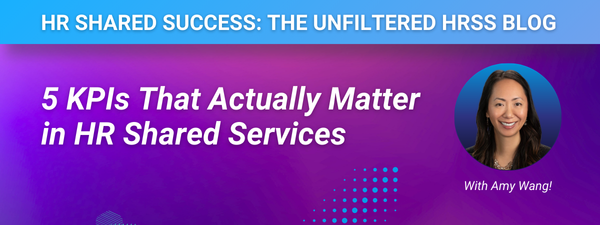5 KPIs That Actually Matter in HR Shared Services

Many HR Shared Services teams are under pressure to show results. It’s common to be asked for metrics, dashboards, and proof of efficiency. So, the focus often shifts to what’s easiest to measure: case volume, average response times, and SLA compliance. Those metrics have value, but they don’t always tell the full story - especially for teams that don’t operate in a call center model or use ticketing systems. In many HRSS environments, the work is done by centralized specialists who support multiple organizations. The day-to-day isn’t just about closing tickets. It’s about helping people make decisions, understand policies, and navigate complex situations. That kind of support doesn’t always show up clearly in traditional metrics. Below are five KPIs that offer a more complete picture of what shared services can deliver. They can be tracked without a formal system and are especially relevant for teams focused on quality, clarity, and trust rather than just volume or speed.

"Time to close" might tell you when a question was answered, but it doesn’t show if the answer made sense. What matters more is how quickly someone gets the right answer in a way they can understand and use. Look for patterns in back-and-forth conversations. Are employees reaching out again because something was confusing? Are managers asking the same questions in different ways? These patterns can highlight where things aren’t landing clearly.

It’s easy to send a survey and ask if people “trust HR,” but behavior tells you more. Are managers following the guidance provided? Are employees using the tools available, or are they going around them? Do internal partners involve HRSS early, or only when something has already gone wrong? Trust signals show up in repeat behavior, escalation patterns, and informal feedback. When people rely on your team, you notice it. When they don’t, you notice that too.

This combines two ideas: Did the issue get resolved correctly the first time, and did the person need to come back again? High-quality resolution means the issue was fully addressed without follow-ups, rework, or clarification. When people return with the same question, or when others repeatedly struggle with the same process, it’s a sign something was missed. Even without a case management tool, you can observe this by looking at email chains, re-opened issues, or feedback from business partners. Over time, these patterns help you spot what’s working and what’s not.

If you’ve created digital forms, templates, or knowledge articles, are people actually using them? And just as important, are they using the right ones? Low usage might mean people don’t know the resources exist, don’t trust them, or find them too hard to follow. Even without system analytics, you can watch for signs. Are you answering questions that are already in your FAQs? Are people bypassing self-service tools and coming straight to your team? That says something about their usability.

Every team has processes that break down sometimes. Exception Rate looks at how often that happens. Manual workarounds, off-cycle requests, skipped steps, and urgent escalations are all signs that a process isn’t working as expected. You can track exceptions with a simple log or by having regular team discussions about what didn’t go smoothly. This is especially useful during system changes or new rollouts, when gaps often surface.

These five KPIs aren’t about checking boxes. They’re about understanding whether your HR Shared Services team is helping people work more confidently and efficiently. You don’t need a complex system to know if your guidance is landing clearly, if people trust your team, or if your processes are effective. The key is to pay attention to the behaviors and patterns that show up every day.
Here are three questions to come back to:
- Are we easy to work with?
- Do people trust what we provide?
- Are we helping make work simpler, not more confusing?
If the answer is yes, the rest tends to follow. If not, no metric will fix it.

If your priority is the digital self-service experience (portals, chatbots, knowledge articles) - not just general HRSS reporting - grab our worksheet: “5 Key KPIs for Tracking HR Self-Service Effectiveness in 2025.” It focuses exclusively on self-service outcomes so you can benchmark like-for-like and act fast.
You’ll compare your self-service against 2025 targets for:
- Self-Service Adoption – are employees using digital tools first?
- SLA Compliance – are self-service requests being completed within expected timeframes?
- Customer Satisfaction (CSAT) – how do employees rate their digital HR experience?
- Resolution Quality – are issues fully resolved without escalation?
- Cost per Transaction – what’s the efficiency and ROI of your self-service model?
📊 View the Self-Service KPI Worksheet
About the Author
Amy Wang shares real-world insights of organizational transformation across HR, IT, finance, and shared services. With experience spanning higher education, healthcare, and automotive industries, she brings a grounded perspective to leading change in complex environments. Amy also serves as a strategic advisor on AI integration, helping organizations align technology with workforce strategy.
She started using #HRRealTalk to open up more honest conversations about leadership, change, and the human side of complex systems. She writes about what actually works, lessons learned, and how to lead with both clarity and empathy.
Connect with Amy on LinkedIn: linkedin.com/in/amywang168
Amy Wang | Voice of Real Talk in HR and Organizational Transformation

